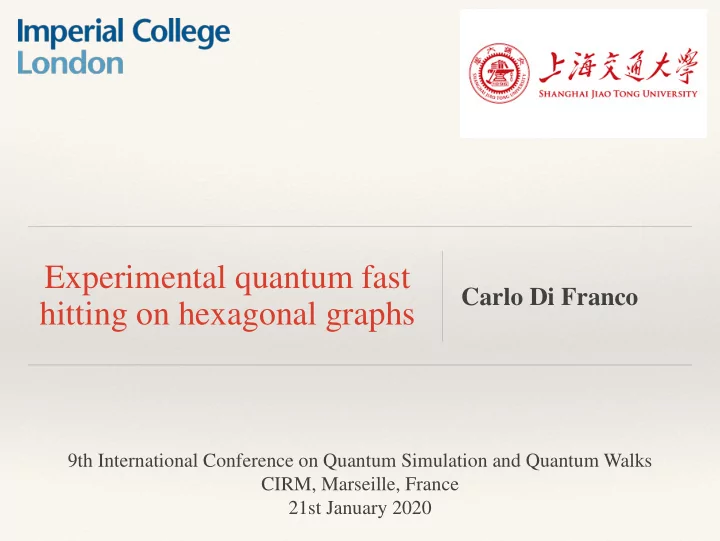

Experimental quantum fast Carlo Di Franco hitting on hexagonal graphs 9th International Conference on Quantum Simulation and Quantum Walks CIRM, Marseille, France 21st January 2020
Outline ❖ A feasible experimental platform for implementing quantum protocols ❖ Standard glued tree problem ❖ Hexagonal graph and its realisation ❖ Experimental results ❖ Summary
Outline ❖ A feasible experimental platform for implementing quantum protocols ❖ Standard glued tree problem ❖ Hexagonal graph and its realisation ❖ Experimental results ❖ Summary
Experimental platform Bulk optics experiments
Experimental platform Bulk optics experiments Integrated waveguide circuits
Experimental platform
Experimental platform
Experimental platform
Experimental platform
Experimental platform
Experimental platform They can print 3D chips !
Experimental platform They can print 3D chips ! 2D graph + time
Experimental platform They can print 3D chips ! 2D graph + time Question: How to exploit it ?
Outline ❖ A feasible experimental platform for implementing quantum protocols ❖ Standard glued tree problem ❖ Hexagonal graph and its realisation ❖ Experimental results ❖ Summary
Glued tree
Glued tree
Glued tree Entry Exit
Glued tree Entry Exit
Glued tree Classical Exponential hitting time
Glued tree Quantum J J J J J J J J
Glued tree Classical Exponential hitting time Quantum Linear hitting time
Glued tree Classical Exponential hitting time Quantum Linear hitting time Reason: coherent evolution of the quantum walk
Outline ❖ A feasible experimental platform for implementing quantum protocols ❖ Standard glued tree problem ❖ Hexagonal graph and its realisation ❖ Experimental results ❖ Summary
Experimental implementation Technical constraints:
Experimental implementation Technical constraints: Number of nodes (waveguides) grows exponentially with the number of layers
Experimental implementation Technical constraints: Number of nodes (waveguides) grows exponentially with the number of layers Hopping term depends on the distance between the waveguides
Experimental implementation
Experimental implementation
Outline ❖ A feasible experimental platform for implementing quantum protocols ❖ Standard glued tree problem ❖ Hexagonal graph and its realisation ❖ Experimental results ❖ Summary
Experimental results (a) 20.7mm (b) 22.7mm, (c) 24.7mm (d) 26.7mm (e) 28.7mm
Experimental results (a) 20.7mm (b) 22.7mm, (c) 24.7mm (d) 26.7mm (e) 28.7mm Hitting efficiency Evolution length (mm)
Experimental results
Experimental results (a) 3 layers: 30.4mm, (b)4 layers: 43.7mm, (c) 5 layers: 48.4mm, (d)6 layers: 61.8mm, (e) 7 layers: 70.8mm, (f) 8 layers: 85.8mm.
Experimental results (a) 3 layers: 30.4mm, (b)4 layers: 43.7mm, Up to 160 nodes ! (c) 5 layers: 48.4mm, (d)6 layers: 61.8mm, (e) 7 layers: 70.8mm, (f) 8 layers: 85.8mm.
Experimental results Optimal length (mm) Number of layers
Experimental results Optimal length (mm) Number of layers Quantum linear hitting time !
Outline ❖ A feasible experimental platform for implementing quantum protocols ❖ Standard glued tree problem ❖ Hexagonal graph and its realisation ❖ Experimental results ❖ Summary
Summary ❖ We experimentally demonstrated that the quantum hitting time grows linearly in our hexagonal structure ❖ We have a coherent evolution of a quantum walk on a graph with up to 160 nodes
Thanks for your attention H. Tang, C. Di Franco, et al., Nature Photonics 12 , 754 (2018)
Recommend
More recommend